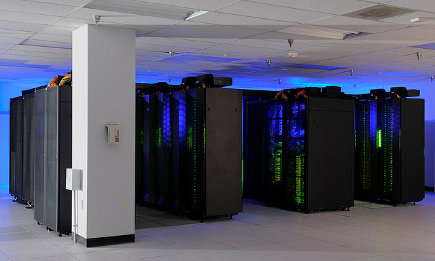The new scientific paradigm

Without supercomputers the integration of these models for oceanic, atmospheric and sea ice developments would not have been possible. At the Netherlands eScience Center (NLeSC) Frank Seinstra works with scientists from around the country to identify and exploit even more applications of high performance distributed computing.
“In 2007 my team and I were already researching high performance distributed computing. Back then I was really intrigued to find out how we could facilitate the use of supercomputers to drive scientific breakthroughs. It was not only fundamental research but also the application was at least as interesting. We had already decided to focus on the impact computers could have on science, rather than purely the computer science itself. This emphasis is at the heart of what we are now doing at NLeSC. ”
Together with his team, Seinstra managed to earn grants for their plans. “We were awarded €2,5 million for research and the application of our results. With this we could set up an intensive cooperation with climate researchers, astronomers as well as multi-media analysts.”
Evolution of star clusters over time
eScientists with broad cross-disciplinary interests and desire to deliver a new type of scientific output often find University careers hard to sustain. Seinstra explains, “there were lots of great opportunities to continue my work in the traditional University environment, but none of them would allow me to fully focus on delivering new software solutions, scientific algorithms and workflows that I had come to realize would underpin scientific breakthroughs in the coming years. Delivering peer-reviewed articles was not enough for me. I wanted to also use my scientific and technological skills to drive scientific discovery in whatever form that took.”
The Netherlands eScience Center offered a solution, allowing Seinstra and a number of key colleagues to join this new initiative by SURF and NWO. This way they could continue their existing collaborations with climate researchers and astronomers as well as initiate new partnerships with chemists, plant biologists and scientists from numerous other disciplines.
“The Netherlands eScience Center is still a very young organization, but you can already see the first results of our generalist vision. For instance, we cooperate with Leiden University on the simulation of events in the universe where we look at the evolution of star clusters over time. Those simulations consist of coupled models. All physical aspects are being modeled separately and coupled afterwards.”
“Frankly, enough climate research is being conducted in the same way. We have separate models for the ocean, atmosphere and sea ice. Our work is focused on bringing these models together in a way which transcends the domain. That’s a development we are witnessing more and more at the Netherlands eScience Center.”
Creating mutual commitment
Seinstra, working fulltime as a Senior eScience Engineer devotes part of his time to the eScience Center and part to his project partners. “On the one hand we focus on generalization and application in multiple domains; on the other hand we create mutual commitment by focusing on our project partners. In my opinion that combination is the true value of the eScience Center.”
Altough Seinstra studied fundamental IT science at the VU University in Amsterdam, he is now more concerned with practical applications. One of the reasons for this switch is that many businesses are in need of solutions around big data. “This is illustrated by our latest call for new projects around data science. The possibilities for funding are more and more focused on deriving additional value from public-private partnerships.”
“In my opinion the development in this area has to be two-way. It is very important to remain concerned with fundamental questions in each domain, but we also need to look at more practical issues. If you aspire a Top 5 position, IT specialists should look beyond the theory.”
The Netherlands eScience Center is very important in that ambition. “What we really need is a change in mindset. To bridge the gap between science and industry on the one hand, and advanced computational infrastructure on the other, we need a lot of expertise. And a lot of well educated people. We are not there yet as this change in mindset has to gain ground in universities, but in my opinion, the Netherlands eScience Center offers a great possibility to bring the right expertise and the right people together. That is a great step forward.”
Meest Gelezen
Wederom intimidatie van journalisten door universiteit, nu in Delft
‘Burgerschapsonderwijs moet ook verplicht worden in hbo en wo’
Raad van State: laat taaltoets nog niet gelden voor hbo-opleidingen
Vrouwen houden universiteit draaiende, maar krijgen daarvoor geen waardering
Extra geld voor bètafaculteiten is daar nooit terechtgekomen

